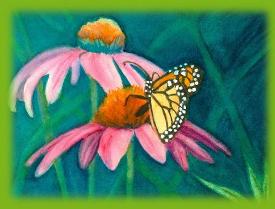 prowicz family winter sowing
prowicz family winter sowing
how to start native plants from seed
by making harsh zone 5 winters work for you
(this entry was written sometime in 2003; I have updated it for 2013)
laura is pretty sure that winter sowing is her new main hobby, an offshoot of gardening. winter sowing. there are so many different facets of fun that it's hard to quantify them all :-)
first there is the choosing and dreaming of the flowers that the seed may bring. then there is the fun of deciding on which to purchase. next comes the actual purchasing and receiving of the seed. then, finally, the culmination of the process with the sowing of the seeds into the chosen receptacle and getting the seeds outside *where they belong* (assuming of course that they are hardy perennials, biennials or annuals).
what is "winter sowing", you ask? it's a technique for starting plants from seed and it's so easy, you could call it the lazy gardener's method.
instead of purchasing special equipment, lights, shelves, potting medium, etc. etc.:
- during the year, save chinese takeout containers and frozen food trays (flats.)
- in january or so, slit the bottom of the containers for drainage and then fill them with the cheapest potting soil you can find.
- take your native plant seeds and sprinkle them on top.
- water the flats liberally.
- slit the tops of the containers and cover them.
- if you don't have a cover, you can make one using a large (frozen foods) ziploc baggy, which still requires slits.
- put the seeds outside in the weather and don't do a darn thing for three months.
- after three months, go outside and suddenly there are plants! :-)
enough talking! onto the photos...
| |
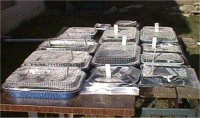 flats april 1 2003 |
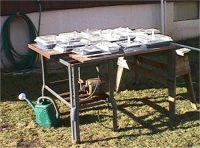 flats april 1 2003 |
you know the flats are moist enough when you see condensation on the lids. no condensation means either water the flats or the slits in the lids are too large (very scientific.) when it gets really warm outside open the vents in the lids or take the lids off. apparently the only thing to be careful of is making sure you don't accidentally fry your plants inside their little greenhouses. by april 5th the only thing I had done was check the flats to find that some of them (most actually) had two-leaved seedlings inside. I hadn't even watered them once since setting them outside in january, the melting snow had done it for me. | |
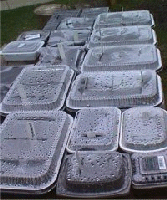 flats april 5 2003 condensation is key |
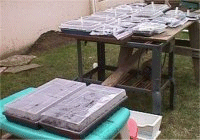 flats april 5 2003 make sure you see evidence of moisture |
why it worksmost native plants (and some non-hardy perennials and annuals) have to go through a period of cold, like winter, in order to break the seed's dormancy and germinate. putting the seeds outside during the really cold winter months does this very effectively and simply. the seeds germinate when the time is right and they are much more robust and hardy than plants started indoors in an artificial environment. for plants that do not need a cold period, I sowed them exactly the same and put them outside starting in early april to give them a few weeks head start before going into the garden. | |
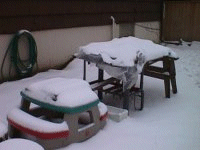 last snowstorm april 7 2003 |
this was an amazing transformation. the flats had been through warm and cold and three inches of snow, this last storm on april 7th... |
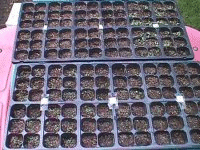 winter sowing flats april 20 2003 |
...just about two weeks later, viola! plants! :-) winter sowing - "seed starting for the lazy gardener" (I just really have better things to do than to babysit seedlings all winter!) |
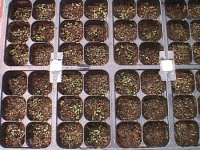 winter sowing flats april 20 2003 |
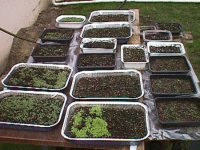 winter sowing flats april 20 2003 |
| even joe-pye weed, which I have read is notoriously hard to start from seed, germinated without any trouble and is healthy and robust. | |
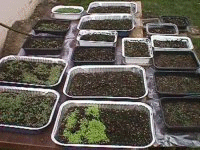 winter sowing flats april 20 2003 |
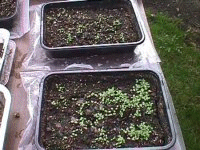 winter sowing flats april 20 2003 |
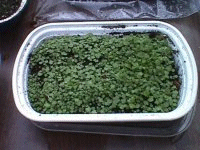 winter sowing flats april 20 2003 |
the anise hyssop were the first to take off and are the most vigorous of the crew. |
|
here are the flats again on may 9th. the seedlings are doing great. I still keep them covered at night but when it's over 60 degrees F during the day, I leave them uncovered. | |
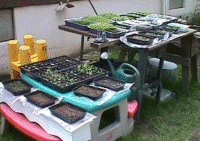 winter sowing flats may 9 2003 |
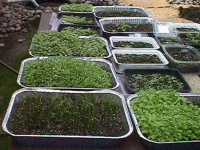 winter sowing flats may 9 2003 |
planting the seedlingssince there are so many concentrated populations of seedlings in the flats, the most efficient way to plant them is called "hunk o seedlings" style. take a tea or soup spoon, dig out a hunk of seedlings and plant them as if they were one "plant". some of them will die and some will take off, and they can be thinned or divided the following season. using this method, some of the seedlings even flowered the first year! (hyssop, joe-pye) | |
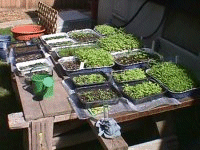 winter sowing flats may 21 2003 |
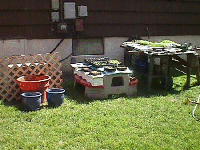 winter sowing flats may 21 2003 |
| for lots more information about winter sowing, see the gardenweb winter sowing forum. | |
 |
 |
| web site graphics groovy lizard web design | |